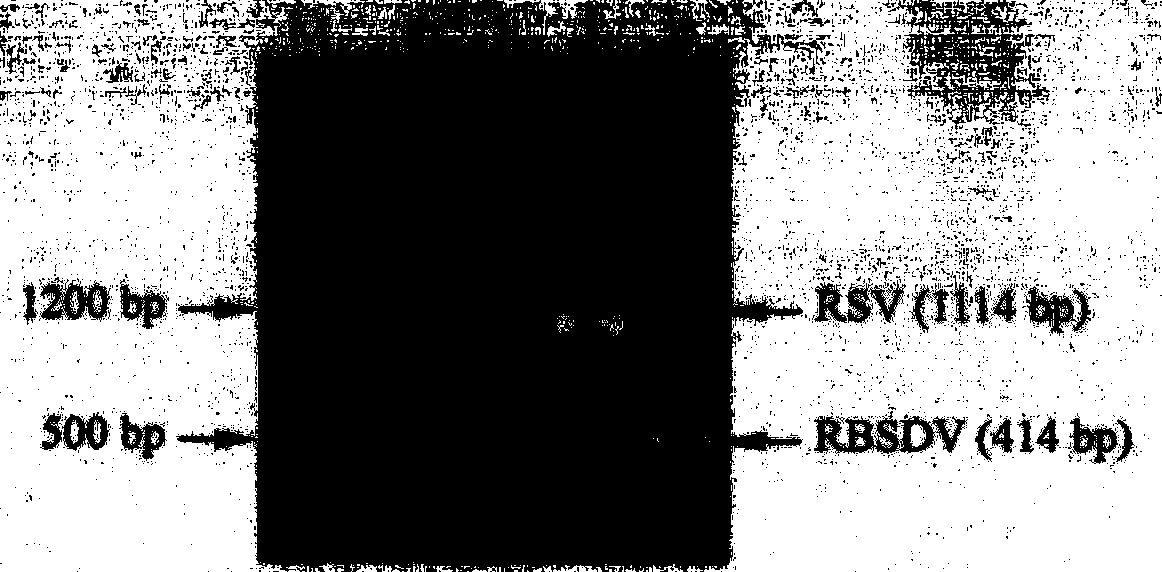Method for quickly detecting rice stripe virus and rice black-streaked dwarf virus in laodelphax striatellus
A technology for rice stripe virus and rice black stripe dwarfing, which is applied in the directions of biochemical equipment and methods, and the determination/inspection of microorganisms to achieve the effect of a specific identification method
- Summary
- Abstract
- Description
- Claims
- Application Information
AI Technical Summary
Problems solved by technology
Method used
Image
Examples
example 1
[0039] Example 1: Detection of virus-carrying (RSV) striatellus striatellus after feeding poisonous rice plants with black-streaked dwarf disease
[0040] 1. Toxic mediator
[0041] The mediator SBPH is screened and preserved in this laboratory, and the screening method refers to the method of Liu Haijian et al. (Each bottle has 3-4 rice seedlings at the two-leaf stage, the variety is Wuyujing No. 3), and each head of SBPH is marked, and it is taken out after 3-4 days after laying eggs, and the female parent is detected. The situation of carrying poisonous (RSV) of lice, its progeny continue to raise standby. Select a family with a higher hatch rate and a female parent that is infected with the virus and feed it for 3-4 generations, then detect the virus-carrying condition of its offspring to determine the virus-carrying rate of the family, and raise it for later use.
[0042] 2. Feed poison of SBPH
[0043] The diseased plants showing typical symptoms of rice black-streake...
example 2
[0074] Example 2: Simultaneous detection of the poisonous situation of the SBPH population in the field
[0075] In the spring of 2013, a checkerboard method was used to collect overwintering generations of SBPH in several wheat fields in Gaochun County, Nanjing City, Jiangsu Province. A total of 2,000 heads were collected at random. After freezing, 150 heads were randomly selected. RNA was extracted according to the method in Example 1, and RT-PCR was performed with 3 primers. Detection, it was found that 3 SBPHs carried RSV (a band of 1114bp size was detected), 2 SBPHs carried RBSDV (a band of 414bp size was detected), and no SBPH carried two viruses at the same time, calculated In 2013, the overwintering generation of SBPH in Gaochun area carried RSV: 2% and RBSDV: 1.3%, which provided data support for the prediction and prevention of viral diseases.
example 3
[0076] Example 3: Detection of rice disease samples
[0077] Rice samples infected with RSV and RBSDV respectively and mixed samples infected with RSV and RBSDV were used as detection objects, and healthy rice samples were used as negative controls. Extract RNA according to the method of example one, carry out RT-PCR detection with 3 primers, as a result the sample that infects RSV can detect the band of 1114bp size, the sample that infects RBSDV can detect the band of 414bp size, infects two kinds of viruses The mixed sample can detect bands of 1114bp and 414bp at the same time, and no band is detected in the healthy rice sample, which shows that this detection method is also applicable to the detection of rice samples. Of course, since the symptoms of rice samples infected with RSV and RBSDV are very easy to distinguish in the field, the detection of rice disease samples can be used for the early detection of rice disease before the symptoms are manifested, and it is not com...
PUM
 Login to View More
Login to View More Abstract
Description
Claims
Application Information
 Login to View More
Login to View More - R&D
- Intellectual Property
- Life Sciences
- Materials
- Tech Scout
- Unparalleled Data Quality
- Higher Quality Content
- 60% Fewer Hallucinations
Browse by: Latest US Patents, China's latest patents, Technical Efficacy Thesaurus, Application Domain, Technology Topic, Popular Technical Reports.
© 2025 PatSnap. All rights reserved.Legal|Privacy policy|Modern Slavery Act Transparency Statement|Sitemap|About US| Contact US: help@patsnap.com



